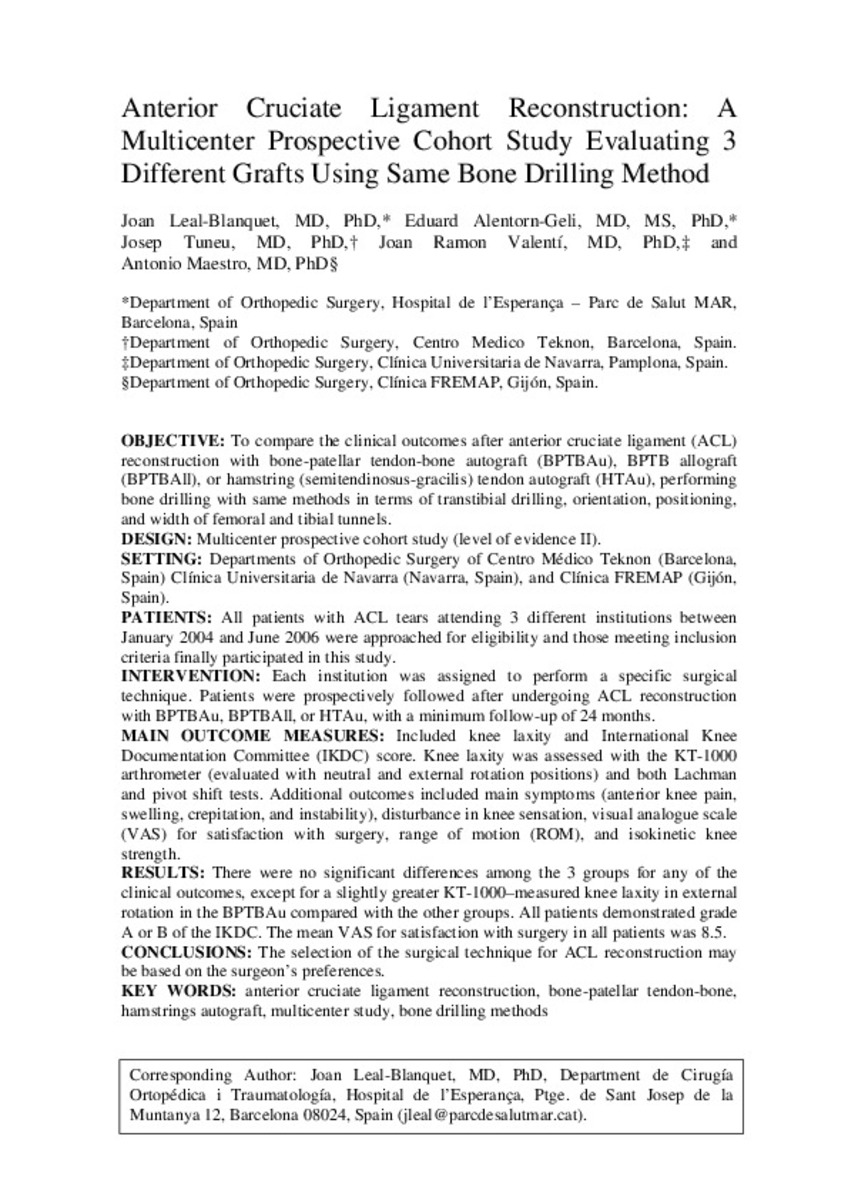Full metadata record
| DC Field | Value | Language |
|---|---|---|
| dc.creator | Leal-Blanquet, J. (Joan) | - |
| dc.creator | Alentorn-Geli, E. (Eduard) | - |
| dc.creator | Tuneu, J. (Josep) | - |
| dc.creator | Valenti-Nin, J.R. (Juan Ramón) | - |
| dc.creator | Maestro, A. (Antonio) | - |
| dc.date.accessioned | 2012-10-22T07:11:13Z | - |
| dc.date.available | 2012-10-22T07:11:13Z | - |
| dc.date.issued | 2011 | - |
| dc.identifier.citation | Leal-Blanquet J, Alentorn-Geli E, Tuneu J, Valentí JR, Maestro A. Anterior cruciate ligament reconstruction: a multicenter prospective cohort study evaluating 3 different grafts using same bone drilling method. Clin J Sport Med. 2011 Jul;21(4):294-300. | es_ES |
| dc.identifier.issn | 1050-642X | - |
| dc.identifier.uri | https://hdl.handle.net/10171/23431 | - |
| dc.description.abstract | To compare the clinical outcomes after anterior cruciate ligament (ACL) reconstruction with bone-patellar tendon-bone autograft (BPTBAu), BPTB allograft (BPTBAll), or hamstring (semitendinosus-gracilis) tendon autograft (HTAu), performing bone drilling with same methods in terms of transtibial drilling, orientation, positioning, and width of femoral and tibial tunnels. DESIGN: Multicenter prospective cohort study (level of evidence II). SETTING: Departments of Orthopedic Surgery of Centro Medico Teknon (Barcelona, Spain) Clinica Universitaria de Navarra (Navarra, Spain), and Clinica FREMAP (Gijon, Spain). PATIENTS: All patients with ACL tears attending 3 different institutions between January 2004 and June 2006 were approached for eligibility and those meeting inclusion criteria finally participated in this study. INTERVENTION: Each institution was assigned to perform a specific surgical technique. Patients were prospectively followed after undergoing ACL reconstruction with BPTBAu, BPTBAll, or HTAu, with a minimum follow-up of 24 months. MAIN OUTCOME MEASURES: Included knee laxity and International Knee Documentation Committee (IKDC) score. Knee laxity was assessed with the KT-1000 arthrometer (evaluated with neutral and external rotation positions) and both Lachman and pivot shift tests. Additional outcomes included main symptoms (anterior knee pain, swelling, crepitation, and instability), disturbance in knee sensation, visual analogue scale (VAS) for satisfaction with surgery, range of motion (ROM), and isokinetic knee strength. RESULTS: There were no significant differences among the 3 groups for any of the clinical outcomes, except for a slightly greater KT-1000-measured knee laxity in external rotation in the BPTBAu compared with the other groups. All patients demonstrated grade A or B of the IKDC. The mean VAS for satisfaction with surgery in all patients was 8.5. CONCLUSIONS: The selection of the surgical technique for ACL reconstruction may be based on the surgeon's preferences | es_ES |
| dc.language.iso | eng | es_ES |
| dc.publisher | Lippincott, Williams & Wilkins | es_ES |
| dc.rights | info:eu-repo/semantics/openAccess | es_ES |
| dc.subject | Muscle Strength/physiology | es_ES |
| dc.subject | Muscle, Skeletal/surgery | es_ES |
| dc.subject | Bone-Patellar Tendon-Bone Graft/*methods | es_ES |
| dc.title | Anterior cruciate ligament reconstruction: A multicenter prospective cohort study evaluating 3 different grafts using same bone drilling method | es_ES |
| dc.type | info:eu-repo/semantics/article | es_ES |
| dc.type.driver | info:eu-repo/semantics/article | es_ES |
| dc.identifier.doi | http://dx.doi.org/10.1097/JSM.0b013e31822153cb | es_ES |
Files in This Item:
Statistics and impact
Items in Dadun are protected by copyright, with all rights reserved, unless otherwise indicated.






